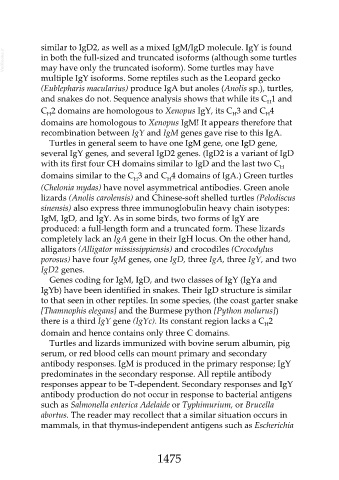Page 1475 - Veterinary Immunology, 10th Edition
P. 1475
similar to IgD2, as well as a mixed IgM/IgD molecule. IgY is found
VetBooks.ir in both the full-sized and truncated isoforms (although some turtles
may have only the truncated isoform). Some turtles may have
multiple IgY isoforms. Some reptiles such as the Leopard gecko
(Eublepharis macularius) produce IgA but anoles (Anolis sp.), turtles,
and snakes do not. Sequence analysis shows that while its C 1 and
H
C 2 domains are homologous to Xenopus IgY, its C 3 and C 4
H H H
domains are homologous to Xenopus IgM! It appears therefore that
recombination between IgY and IgM genes gave rise to this IgA.
Turtles in general seem to have one IgM gene, one IgD gene,
several IgY genes, and several IgD2 genes. (IgD2 is a variant of IgD
with its first four CH domains similar to IgD and the last two C H
domains similar to the C 3 and C 4 domains of IgA.) Green turtles
H
H
(Chelonia mydas) have novel asymmetrical antibodies. Green anole
lizards (Anolis carolensis) and Chinese-soft shelled turtles (Pelodiscus
sinensis) also express three immunoglobulin heavy chain isotypes:
IgM, IgD, and IgY. As in some birds, two forms of IgY are
produced: a full-length form and a truncated form. These lizards
completely lack an IgA gene in their IgH locus. On the other hand,
alligators (Alligator mississippiensis) and crocodiles (Crocodylus
porosus) have four IgM genes, one IgD, three IgA, three IgY, and two
IgD2 genes.
Genes coding for IgM, IgD, and two classes of IgY (IgYa and
IgYb) have been identified in snakes. Their IgD structure is similar
to that seen in other reptiles. In some species, (the coast garter snake
[Thamnophis elegans] and the Burmese python [Python molurus])
there is a third IgY gene (IgYc). Its constant region lacks a C 2
H
domain and hence contains only three C domains.
Turtles and lizards immunized with bovine serum albumin, pig
serum, or red blood cells can mount primary and secondary
antibody responses. IgM is produced in the primary response; IgY
predominates in the secondary response. All reptile antibody
responses appear to be T-dependent. Secondary responses and IgY
antibody production do not occur in response to bacterial antigens
such as Salmonella enterica Adelaide or Typhimurium, or Brucella
abortus. The reader may recollect that a similar situation occurs in
mammals, in that thymus-independent antigens such as Escherichia
1475

